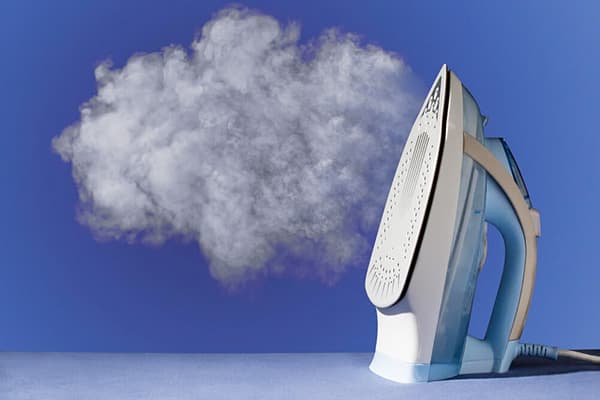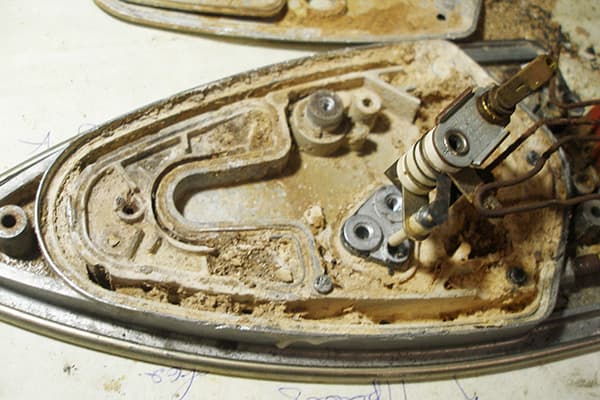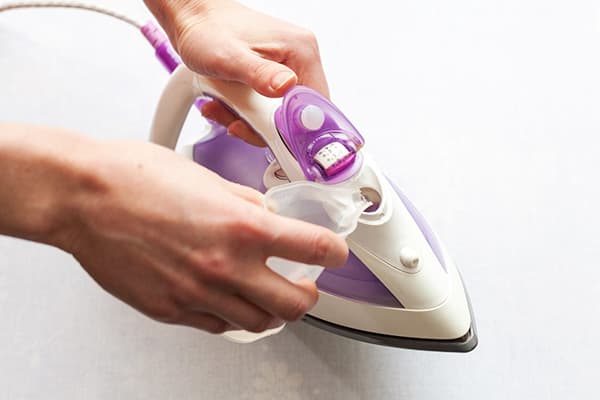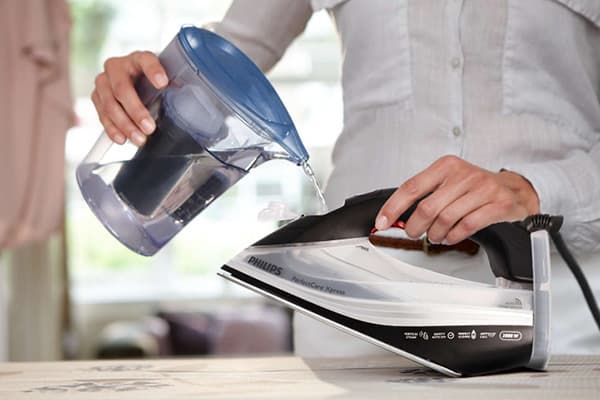Why is it forbidden to pour distilled water into an iron with a steamer?
Most companies that produce household appliances indicate in their instructions that distilled water cannot be poured into the iron. At the same time, the use of tap water causes scale to form on the heating element due to the salts it contains. Let's figure out why such a ban was introduced, whether there are grounds for it, and how to fill the tank so that the home steamer lasts as long as possible.

How does a steam iron work?
It has been known since ancient times that if you iron wet items, the result will be better. Fabric fibers soaked in liquid become softer. By evaporating, moisture reduces friction between individual fibers. Previously, when ironing, they used wet gauze or a spray bottle, which was used to spray the item before ironing.
Today, a special unit has been introduced into the design of the iron - a steamer. It includes a reservoir that contains water and a device for regulating its supply to the heating element. Upon contact with a hot heating element (its temperature is about 150°C), water instantly turns into steam. But the salts contained in the water cannot turn into steam - they settle in the form of crusts on the surface of the iron. This is how scale forms.
In the instructions, manufacturers recommend using tap water to fill steamer tanks. But these are general recommendations; they are written without taking into account the specifics of water supply in different countries and regions.Not in all areas the quality of tap water allows you to avoid scale formation.
How is scale harmful?
A crust of salts that forms on the heating element negatively affects the performance of the iron. This influence has several manifestations:
- Salt deposits are poor conductors of heat. This means that the soleplate of the iron heats up more slowly. At the same time, the heating element remains in a heated state longer - the risk that it will burn out increases.
- During a burst of steam, pieces of scale can fall off the heating element and fall into the tubes through which the steam escapes, clogging them. This reduces the quality of steaming clothes and negatively affects the result.
- Once on the sole, the scale is “smeared” onto the clothes, leaving white marks and stains. It is very difficult to remove these stains from fabric.
If the iron fails due to scale deposits, most companies will refuse to repair or replace the equipment under warranty. The responsibility to monitor the condition of the iron and promptly clean it from scale rests with the user. Violation of the cleaning regime and use of unsuitable water is equivalent to deliberate damage to equipment and is not covered by warranty.
To reduce the risk of scale formation, some iron models are equipped with special cartridges that reduce water hardness. However, the cost of such models is significantly higher than that of conventional irons. Therefore, most users should understand what they can and cannot refill the iron with.
Why can't you use distilled water?
The distillation process removes 99.9% of the salts originally contained in water. The liquid obtained after such cleaning, at first glance, should be ideal for operating a steam generator or steamer in an iron.However, manufacturers say that the distillate has two significant drawbacks:
- The boiling point of water completely devoid of salts becomes higher. This means that the distillate evaporates more slowly. This increases the load on the coating of the evaporation chamber.
- Some salts (for example, bicarbonates) increase the pH of water. If they are removed, the liquid will become more acidic. This means that its destructive effect on metal will intensify, and corrosion processes will proceed faster.
Some experts believe that the ban on the use of distilled water is a ploy by manufacturers. The purpose of the trick is to speed up the failure of the iron, and therefore the purchase of a new one. However, supporters of this point of view are in the minority.
The use of distilled water can extend the life of the iron. But to do this you need to mix the distillate with tap water. The proportions depend on the water hardness in the region. The most commonly used ratios are 1:1 and 1:2.
What kind of water should I put in the iron?
Today there are several options for liquids for refilling irons:
- Special solutions with optimal pH values and boiling points. They contain minimal salt content, forming insoluble crusts. Perfume components are added to most solutions. The main disadvantage of such liquids is their high price.
- Tap water. This option is only suitable for areas with soft water. But in most areas of our country the water is too hard.
For most users, it is optimal to use either a mixture of tap water with distilled water, or water passed through a household filter with a softening cartridge.




I have been using distilled water for over 5 years now. Purely. No scale. My job is that I iron for 2-3 hours every day.
Before this I used regular water. The iron then failed after a year. So much scale accumulated in a week. They picked it out and picked it out. Something was damaged.
I don’t know any grief with distillate.
+100500 I have been using only distilled water in my iron for 9 years, like new.
Of course, the call to use undistilled water is pure deception! pH dist. water is 7, i.e. it is neutral. Alkali actively corrodes, for example, aluminum. Try holding the aluminum plate in conc. Caustic solution (NaOH) - and you will see how the surface will acquire a very noble matte texture. About increasing the boiling point - this is just a “clinic”! It is with distilled water that it is equal to 100 degrees, and with an increase in the number of salts it does not increase, because the water evaporates as usual, AT THE SAME 100 degrees, and the salts do not evaporate, but settle in the iron, disabling it, closing the heating element! It’s just profitable for the company that you buy a new iron! The earlier the better!
Imagine how much iron manufacturers hate you!
The only thing is that distillate has lower conductivity, so the sensors of the heating tank and water drainage tank may malfunction. Miele sometimes asks to fill the drain tank (no matter how stupid it may sound), and then drain it so that the system understands the difference again. There is no such thing on Laura, there is a sore with the solenoid valve.
Complete nonsense. The temperature of distilled water is LOWER than with salts. And the acidity of distilled water is NEUTRAL. The pH of the salts dissolved in it is changed.
Svetlana, you missed the word “boiling” after the word “temperature”, and everything else is “5”.
Three ironing systems. We thought for a long time, suffered, and cleaned up in order to find a compromise. 1:1 distillate to baby water in large cooler bottles
What if it’s just boiled?
What if you teach physics and chemistry at school?
I agree, I use boiled water after it has settled and the insoluble turbidity precipitates
Are the experts familiar with elementary physics? Distilled water boils at 100 degrees - this is an axiom (at normal pressure)! All other salt solutions boil at higher temperatures.
This is all a lie. I’ve been using the same iron for 15 years, everything is fine.
I've been using the same iron for 25 years!!! True, there is no steamer in it...
25 years old is a weakling! I have mine for 50 years - I heat it on gas and at least 4 kg of pure metal and like new!
RAVE! The boiling point of distilled water is EXACTLY 100 degrees Celsius (salted water is MORE). Cold distilled water can absorb carbon dioxide and become slightly acidic (pH 5.4-6.6). But this is very small to cause any harm.Soft water also contains salts, which, when evaporated, remain in the iron and spoil it. (The misconception that soft water does not leave scale is based on the observation of scale deposits in a kettle, BUT there the water almost does not evaporate, and in the iron it evaporates COMPLETELY). Therefore, only distilled water is suitable for irons.
Alexey, above 100 degrees C, water turns into steam, and it doesn’t matter how much salt it contains. Otherwise the conclusion is correct
Clearly, using distilled water prolongs the “life” of the iron. And who doesn’t benefit from this? Arguments about the pH of distilled water are for ignoramuses and poor students, about the boiling point - just for morons.
Clear and clear for everyone!! And there is no need for further verbiage.
Professional steam generators (in other words, steam irons in sewing factories) are filled with ONLY distilled water. Any other liquid is strictly prohibited by the device manufacturer’s instructions. As a production mechanic, once a year, before vacation, I disassemble the distiller, clean and rinse the tank and heating elements. A lot of scale and some kind of small clay mucus, river water from the city network after cleaning. I only pour distillate into the iron at home. The article is either custom-made, or someone decided to troll readers and stir up controversy.
It’s good that they attracted people’s attention, after reading about the consequences of using distilled or running water, people will choose distilled, I use this myself, they brought the iron to be repaired after using running water for a year, they got tired of making holes in the soles, they were clogged with scale.
Namely, “professional steam generators”, and the speech in the article seems to be about mass-produced irons.
Waugh wrote something like: “The Bugatti Veyron is filled with 98 gasoline. Any other is strictly prohibited. As a motor mechanic I service Veyrons. And in my UAZ, instead of 76, I pour 98 and there is almost no detonation and almost nothing burns out.”
Household irons are designed to be easy to maintain (i.e. tap water) and have a short lifespan. Therefore, you should not be so categorical. Although the article does not reveal the answer to the question posed in the title, I did not see any outright stupidity there.
I have been using boiled water for 12 years and no problems!
It contains more salts. Boiling kills germs, and the iron doesn’t care about them.
Boiled water contains less salts than tap water. But they are there. In the disseminated version there are practically none.
A spoonful of salt per liter of water. Stir, taste - salty. Boil (some of the water evaporates), taste - VERY salty. All!!! There is nothing to argue about.
Even in Soviet-made irons I always poured distilled water about 40 years ago.
Isn’t it fate to take water from the kettle after boiling? Some will precipitate, but there will still be enough left. Scum is worse.
There is more salt in boiled water, because... the pure water evaporated.
It feels like the article was written by manufacturers of water for irons. Distilled water is too cheap and a good substitute for their water.
We have been using distilled water for twenty years. Three irons were replaced. The article is the nonsense of a victim of the Unified State Examination.
Well, either it was paid for by the manufacturers of special, expensive “liquids for irons.”
Or, what is even funnier, it was paid for by the manufacturers of irons, which from tap water will become clogged with scale and fail four times more often.
Alas, with the level of education that those who destroyed the Soviet Union finally achieved, ignorance of physics and chemistry, and, indeed, all other sciences, such articles appear all the time, and what’s more, the author is sure that people read and surround her the same morons. And judging what you don’t know is becoming more and more common among today’s youth, since they do not bear responsibility for their words and are confident that everything they have written or said is the pure truth.
It's sad to be honest.
The earth is flat, distilled water is acidic, the author got an “A” in singing at school.
All articles must be edited by scientific commissions; if the articles are false, then those who read them must be paid compensation
Reminds me of the lyrics of the song:
A fool doesn't need a knife
You'll lie to him like three times
And do with it what you want
Inventing bicycles is a much more promising activity against the discovery of previously unknown properties of distilled water. It's time to discuss the composition of automotive antifreeze. And pour some tap water into the cooling system. Do you feel sorry for the radiator and block head? Of course, a car is not an iron
The instructions are also incorrectly translated into Russian. In the original, there is no need to use distilled water, since there is a scale filter, but they translate that you cannot use it. I have been using only distilled water for decades wherever scale may form, I even poured it into the engine (of an old car). And the article is stupid, it’s a disaster if illiterate and stupid people try to reason, use concepts they have no idea about, and then publish it for money
I always use boiled water.
God, why did I read this! Author, march to school to study chemistry for the eighth grade.
Parsifal, at school now they teach not physics and chemistry, but how to contrive to pass the Unified State Exam!
We use reverse osmosis filtered water (this is almost a distillate) and there are no problems with the iron, steam cleaner, or steam generator. Distilled water is NEUTRAL. Boiling point depends more on atmospheric pressure than on salts. For example, on the 25th floor it can be 3-5 degrees lower than on the 1st.
The author is talking nonsense, the boiling point of water is 100°, and the boiling point of the saline solution is only higher due to bound water, clearly a custom post, 10 years of operation of the iron using distillate without repairs, dirt and other troubles
I have been using this iron for over 10 years. I only fill it with distilled water. The article seems custom made to me. Complete nonsense. Iron manufacturers do not benefit from rare sales of goods.
A striking example of demagoguery.
The author heard a ringing, but does not know where it is. Indeed, if you take distilled water, pour it into a vessel perfectly polished from the inside and heat it, protecting it from shocks and vibration, you can reach temperatures of more than 100 degrees Celsius without boiling. But all this is absolutely impossible for an iron.
Where do you get distilled water?
What, stupid iron manufacturers didn’t think of covering the evaporation chambers with something like Teflon, so that the scale would immediately fall off after forming into small particles like dandruff, and not form a crust?
Everything is not true. boiling point dist. water BELOW is usually tenths of a degree, i.e. not significant. Distillation removes all salts, both alkaline and acidic, from water; water cannot be acidic after distillation.
Fuck! Is distilled water highly acidic? Author, buy “additives” for water in the iron yourself, and don’t give people shit! There is not and cannot be a better distilled one for steam.
I’ve been using distilled water for twenty years and can show several working rarity irons as proof. We bought new ones simply because the new ones are lighter and safer.
When we bought a Philips iron, we read in the instructions “fill with distilled water.” The iron has been working safely for 19 years (only 2 years ago the cord and plug were changed).
It is more interesting for the manufacturer to change irons more often, that’s why such advice is given.
The author is fully qualified to govern the state, his place in the government has been tested!
Boiled tap water has always been poured in and will continue to be filled. Our iron is a simple one with a ceramic-coated sole; we bought it at the very beginning of this century.
Rave. Complete lack of knowledge of elementary physics and chemistry!
The absence of salts in water DECREASES the boiling point.
You don’t need to be an expert to understand why manufacturers prohibit the use of distilled water: at the same time, the breakdown of equipment is sharply reduced))
I have moved and repaired more than a dozen irons, and the reason is salts that clog the jets and disrupt the sealing of the silicone cuffs. For the same reason, the iron leaks immediately after filling with water. And yet, I often observed the following picture: scale tears the silicone seal-adapter. That’s why even a recently purchased branded iron that has been “drunk” of tap water is taken to service..
P.S.
But 10 years ago the manufacturer strictly recommended using distillate))
Author, go do your homework, especially chemistry and physics, then maybe you’ll get a C instead of a failure.
I read the comments. So everyone seems to be right, but not quite.
1. Manufacturers usually write “the iron is designed for use with tap water” - everything is correct here. When developing mass technology, it is natural to focus on the masses. It would be foolish to narrow the audience by linking the technique to distilled water.
2. The boiling point of distilled water (other things being equal and natural conditions) is indeed lower than that of tap water. But! Vaporization depends not only on the boiling point. Microscopic particles of salts stimulate the formation of steam (something like this can be observed when you add salt to boiling or even boiling water). Accordingly, all temperature conditions and evaporation chambers are engineered specifically for tap water.
3. Some iron models use built-in water softening cartridges. Accordingly, the contents of the cartridges will be washed out faster with distilled water.
4. And of course, all instructions are written not only for users, but also for passing many certifications (and in a bunch of countries at the same time). Those. if the manufacturers wrote that the service life is 3 years, then to pass certification, be kind enough to describe all the measures so that the iron retains its properties for all three years, and then let it burn with fire.
To summarize. The equipment is made specifically for the use of tap water. This is statistically beneficial for the average user, and also for the manufacturer.
The manufacturer receives more sales and natural failure over time.
Actually, I described why the manufacturer does not recommend distilled water.But what water to use is up to you. Choose. Either ideal operation of the device within its service life, or an eternal, but mediocre iron.
I only drink distilled water. Even if the technology is not designed for it, I am used to treating things with care, even at the expense of comfort.
What a clever girl!!! Thank you
I read many comments here and understood one thing: 1) The manufacturer writes - “you can pour tap water into the iron - a marketing PR move (so that the iron breaks down more often). Since I paid 8,300 for the iron, I will use exclusively distillate. Longer
And who paid almost 50 thousand for an iron!))) and it says to use only tap water... shouldn’t you think about what to use? Today they brought me a cartridge for it for 5,500 after 2 months of use, just sit and think!
Unfortunately, the new steam generator simply does not work with water from a reverse osmosis system; there is almost no steam. The manufacturer responded as follows: “The manufacturer recommends using regular running tap water.
Your water is highly purified, it does not contain microelements that allow the water to evaporate well, thereby the device will produce little steam and may even leak.
Wow???
Well, this is the case if the steam generator does not have a heating element, but an electrode water heater.....after all, distilled water is a good insulator and the electrode heater will not work normally.
the new Brown steam generator (purchased September 2020) refused to work on pure distillate. The steam generator tried to boil and gave an error message about the need for cleaning. They added 1k1 of tap water and it rustled like a darling. A relative only pours distilled water into the Philips - and everything works.
so apparently everything is individual...
Atmospheric gases are dissolved in distilled water: oxygen, nitrogen, argon, carbon dioxide and a small amount of others. Due to dissolved carbon dioxide, distilled water has a slightly acidic environment and its pH is 5.4-6.6. To obtain completely neutral water, it is boiled until carbon dioxide is completely removed (within 30 minutes) and stored in an airtight container.
We bought an expensive iron with a steam generator. I only used distilled water. After 4 months the iron started spitting rust. What's the matter? I'm looking on the Internet for how to clean it. But only about chemistry and physics
Such bullshit. I bought an iron for 9 thou. poured distillate. stroked it once. on the second, calcium fell from it
Guys, turn on your memory if you were in school once. The most harmless thing for all processes is absolutely pure components (including distilled water, where it is used, for example in boilers, batteries, fine chemistry, medicine, etc.). Feel free to pour distillation into your irons, you won’t regret it. Only the iron manufacturer will regret it. that they buy little, business falls!
But apparently no one read about superheated water and the metastable state of superheated liquid on Wikipedia, not everything in physics is for average minds
I also heard a lot of smart people about distilled water and only poured it into the new iron. As a result, not even six months have passed, but while ironing, rust stains things. Before this I used the iron for several years, filled it with water from the filter and everything was fine. Sometimes I descaled it and that was it. Now I don’t know how to remove the rust.